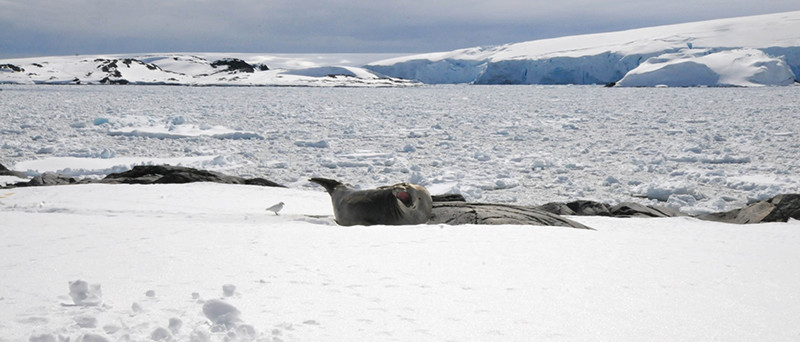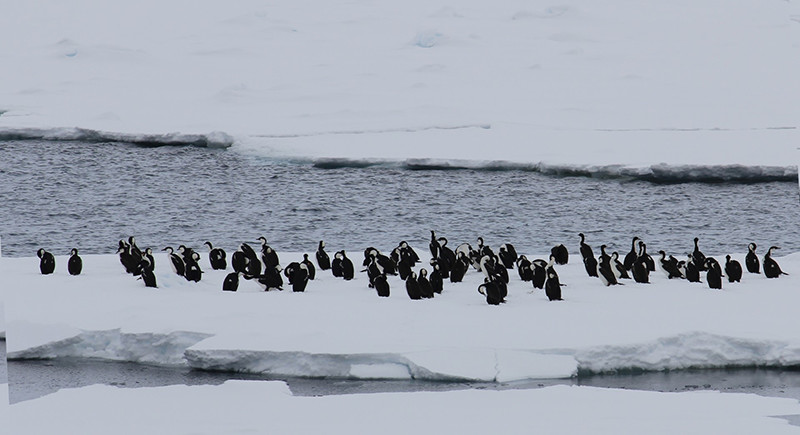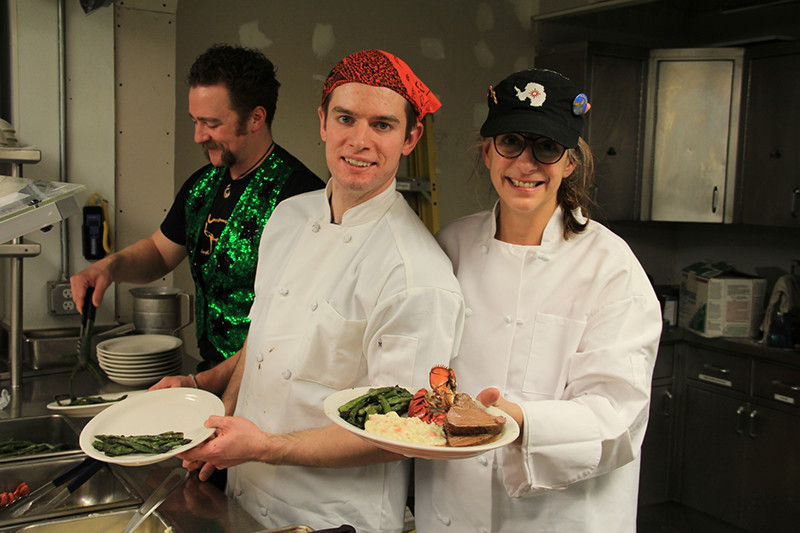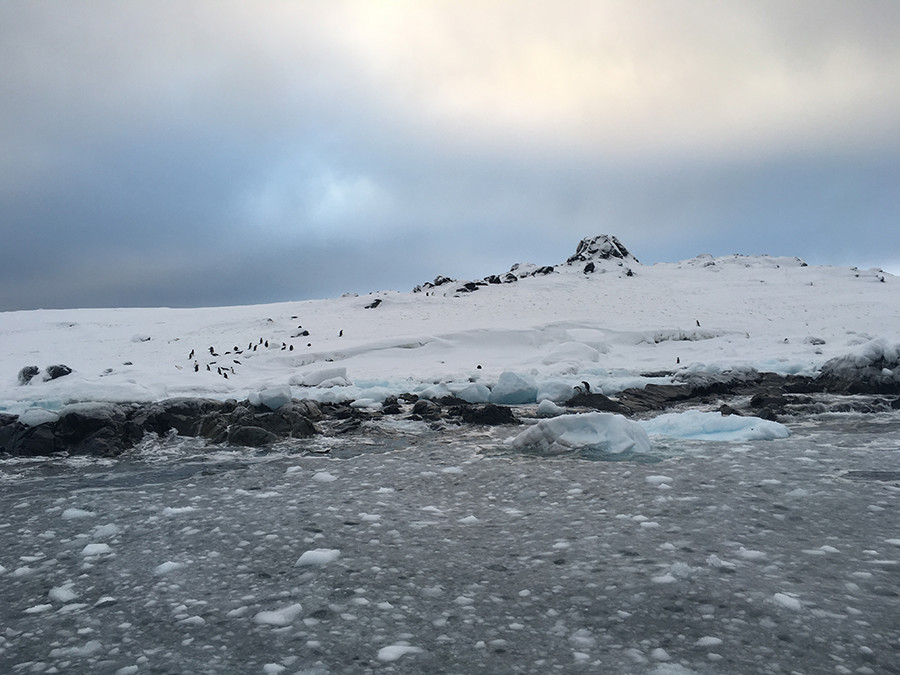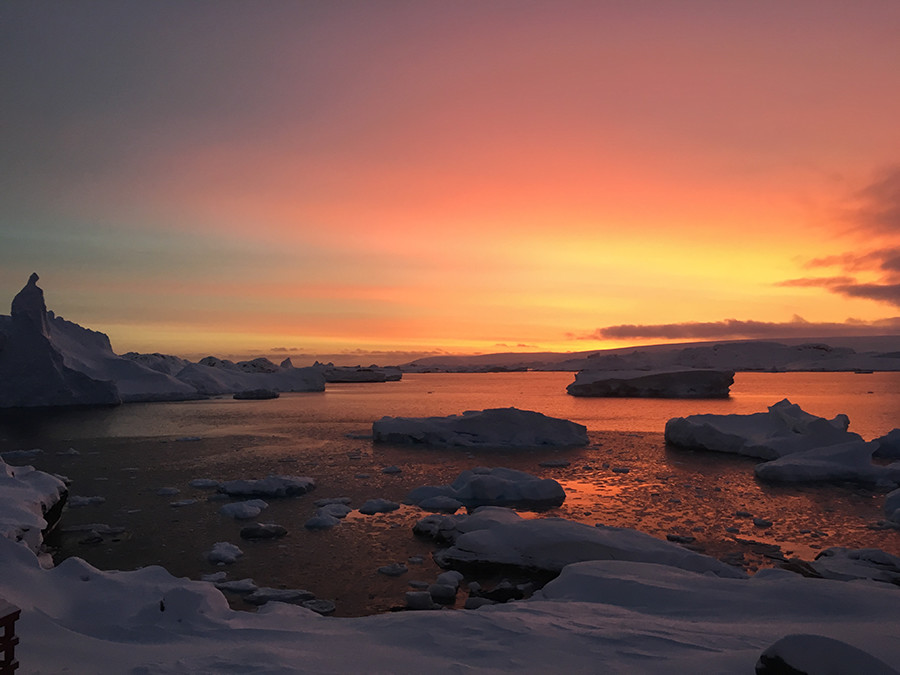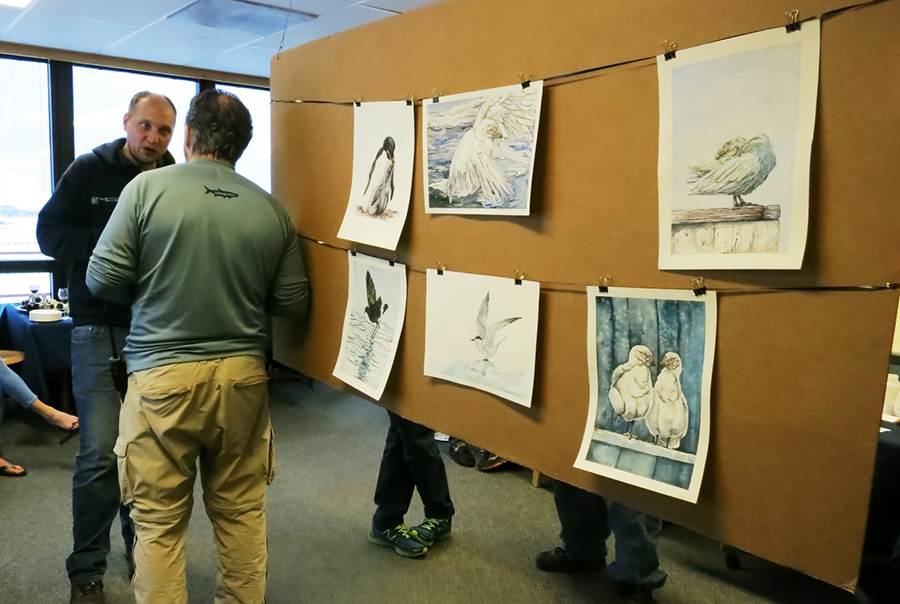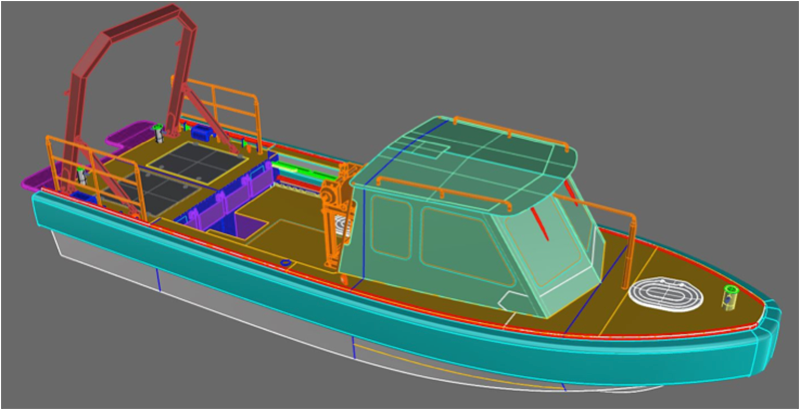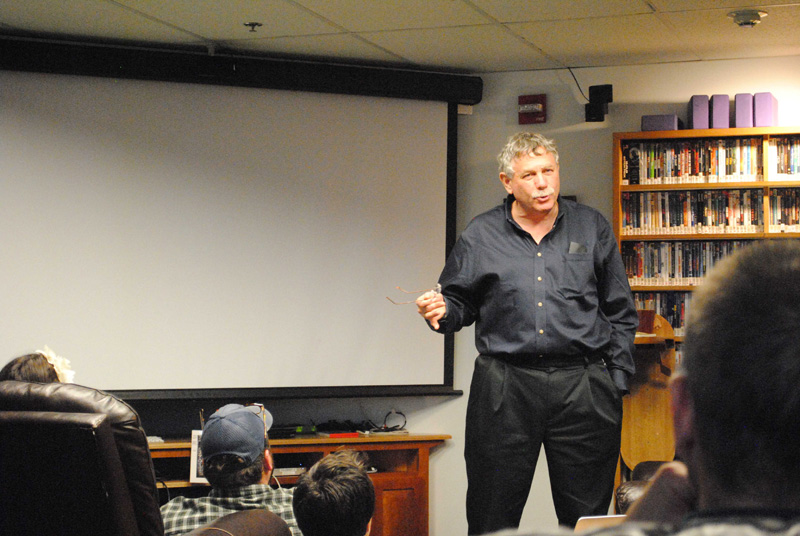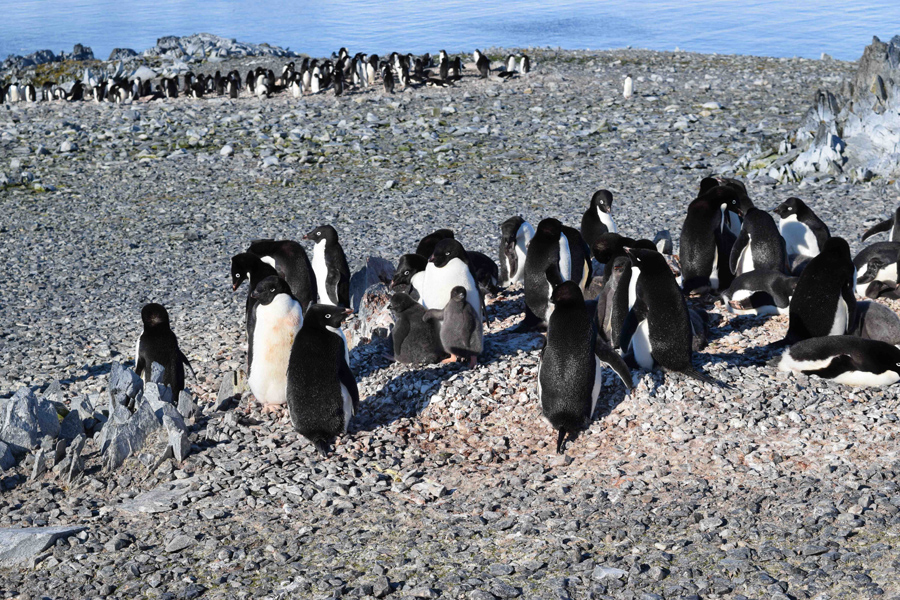|
Palmer Station Archives - 2016 In Full SwingDecember 12, 2016
How do you know that summer has truly arrived in Antarctica? Complaints of insomnia are usually a good indicator– though the sun still rises and sets at Palmer, it barely dips below the horizon, so we now almost get a full 24 hours of light. As we head further into the season, the wildlife is beginning to roam closer to station. At the beginning of the month, large groups of penguins invaded Palmer from all sides, waddling toward station across the abundant sea ice. An elephant seal also set up camp by the pump house for several days and we witnessed a face-off between it and a dangerously curious snowy sheathbill. Science ratcheted up in earnest this month as well. The Antarctic research vessel, Laurence M. Gould, brought two new researchers from Rutgers University, Yuan Gao and graduate student Isatis Rodriguez, who will be studying atmospheric characteristics of the Western Antarctic Peninsula. They have kept busy since their arrival, setting up instruments in Palmer’s ‘backyard.’ One type is their High-Volume Air Sampler and two Micro-Orifice Uniform Deposit Impactors that will collect particles of 10 different sizes from the atmosphere. They’ll also be measuring the moisture and total deposition from precipitation in the area. They’re studying the properties and sources of iron and other trace metals in the air, as these are vital elements of the marine food web. In mid-November, we got some cooperative winds and much of the ice cleared out of Palmer’s boating areas. This was great news for the birders and both of the Palmer Long Term Ecological Research groups. The Schofield and Ducklow science groups were able to sample at sites they hadn’t been able to reach and made use of the landing craft and conductivity, temperature and depth instrument for the first time this season. The landing craft is more spacious than the smaller inflatable boats, and fits all four field team members from the two groups comfortably. A fifth person, a marine technician, helms the boat, freeing more hands to collect water samples. Once these groups get out sampling a few more times, they will be able to start observing the seasonal trends of phytoplankton and bacterial populations in the waters surrounding Palmer Station. November was a big science month for everyone on station, not just the grantees. Early in the month, Jamee Johnson, the S&TPS Palmer Manager, organized a science fair. Most of us participated, contributing projects on topics ranging from ultraviolet protection to memory to earthquakes. Brian Tamm, one of the chefs, even catered to the theme with brain-shaped pâté. The sea-ice retreat has also brought the first opportunities for recreational boating – two groups got the chance to go out this past weekend. Undeterred by the drizzly, foggy conditions, they explored the towering icebergs within the boating area and spotted groups of penguins swimming through the water. We ended the month with a massive Thanksgiving feast. The Gould was here for the last two weeks of November, so we invited the boat crew to the galley to share the holiday meal with us. Many people volunteered to help in the kitchen, peeling and chopping vegetables and stirring away to prepare enough food for the 50 attendees. Station members also contributed nine different kinds of pie to the meal– everyone ended the night full and extremely content. Shifting SeasonsNovember 8, 2016
It’s difficult to believe that we’re already one month into the summer season at Palmer Station. After being postponed a few days in Punta Arenas, a new batch of grantees and support personnel arrived at the station during the second week of October following a smooth crossing of the Drake Passage. Clear blue skies and glassy waters greeted us as we crossed the gangway, and many people took advantage of these relatively rare conditions to head up the glacier near the station as soon as our schedules allowed. But the weather soon shifted, and strong winds brought lots of ice into the surrounding waters, delaying emergency team training as well as the grantees’ ability to start sampling seawater. As the contractors kept busy with turnover, three new science groups began to settle into the labs. With a visit from the Laurence M. Gould this past week, we bid a sad adieu to the wonderful fish-savvy ladies from the Detrich science group and welcomed seven new scientists. Grantees from Hugh Ducklow, Oscar Schofield and Bill Fraser’s teams will be contributing to Palmer’s Long Term Ecological Research (LTER) project this summer, furthering Antarctic food web-related research that has been ongoing since the 1990s. Representing Schofield’s lab, Nicole Waite and Mike Brown will be investigating the phytoplankton in Palmer’s waters, while Adrian Jaycox and Leigh West will examine the ocean’s bacterial populations as a part of Ducklow’s research. Ben Cook, Carrie McAtee and Shawn Farry will study Palmer’s seabirds-- particularly the Adélie penguin colony on Torgersen Island-- with Fraser’s LTER component. October has also been an eventful month for the waste-management logistics teams. The workers have been prepping the station’s hazardous waste to ship back to the States by way of McMurdo Station – a labor-intensive endeavor that occurs every two years at Palmer. The logistics team has been occupied with cargo operations, including the movement of this season’s frozen-food supply from the ship to the large outdoor freezers on station. This particular operation took half of a workday to complete, and required help from the majority of station crew. The volunteers who pitched in were rewarded for braving the cold with visual confirmation of our copious new ice cream supply. Though we work very hard, Palmer residents have a vibrant station life as well. Representatives from the National Science Foundation came to station this month. We welcomed them with a meet-and-greet complete with delectable hors d’oeuvres made by our very talented chefs. We also put together an open mic night during the Gould’s most recent visit at Palmer. Guitars, keyboards and saxophones were played, songs were sung and much clapping and cheering ensued. Station residents also got in the spirit for Halloween, coming together for festive cookie decorating and donned costumes for the party on the 31st. We iced sugar cookie bats, skulls, pumpkins and gravestones, dressed each other up as toilet-paper mummies, played Halloween-themed charades and had a generally spooky and jovial night. Summer has also brought an increase in wildlife sightings. A number of residents saw several gentoo penguins waddling through the snow on station and people are spotting Adélie penguins, seals and seabirds with increasing frequency. All in all, it’s shaping up to be a fantastic season. Wildlife Returns to Palmer StationNovember 8, 2016
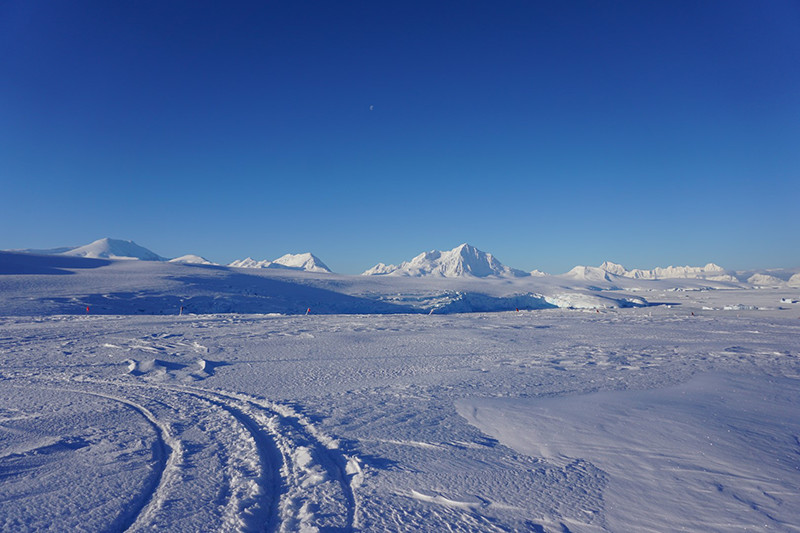
Photo Credit: Julian Race
The top of the glacier offer amazing views of the nearby areas on clear days.
The dead of winter has given way to Southern Hemisphere spring at Palmer Station. Since the solstice in June, we’ve been gaining as much as eight minutes of sunlight a day. We’re currently pushing twelve hours of daylight. Temperatures have also increased. Numb fingers and routine wind chills of minus 15 degrees Fahrenheit are a distant memory. Snowfalls occasionally warm to sleet and rain, with daily temperatures that have reached as high as 35 degrees Fahrenheit! The Antarctic Peninsula’s seasonal transformation has started to come into view, and we’re welcoming the changes with high spirits. During winter, the season’s deep freeze locked the scenery in place. The harbors froze and the glacier hung motionless in the background. One would have to walk to the edge of the water beyond the whir of the generators to hear the subtle constrained pings and groans of ice. Over the course of the next few months, the light and warmth will completely change Palmer’s landscape. We’ve started seeing hints of these changes in the past month. The first few rains permeated through cracks in the glacier, causing their fissures to grow. Popping of the previously seized sheets echoed across Arthur harbor, occasionally releasing a hail of ice into the ocean. Our cherished snow pack has compressed and will soon give way to boulders and bare rock in the backyard and the slick blue ice of the glacier. Small groups of wildlife have come and gone with the weather over the course of the winter. This last month has been especially active. Groups of more than 30 cormorants have been seen flying in formation over station, penguin sightings have become a daily occurrence, and the number of skuas and giant petrels nesting on Bonaparte Point has quickly grown in excess of 100. The landscape is not the only aspect of Palmer that will soon change. Turnover is coming quicker than any of us anticipated. The research vessel Laurence M. Gould is scheduled to arrive at Palmer on October 6th. In anticipation of the coming changes, off hours have been much quieter. Palmer residents are busy prepping and planning for trips that will become travelogues during next winter’s presentation series. We’ve made a lot of progress during the past months and morale is high as we’re entering the final push to finish our winter tasks in time for the summer opening. Indecisive IceAugust 31, 2016
Though Palmer Station is often inundated with fog and low cloud cover this time of year, recently that hasn’t been the case. August brought cold and stable weather, giving way to an unprecedented number of beautiful clear days! It was difficult not to stop and stare at the surrounding scenery some mornings. With the sun still low in the sky, the thin icy clouds overhead lit up like a rainbow. As the sun crept higher, the entirety of Arthur Harbor and the mountains toward Cape Renard to the south were bathed in a golden-purple hue. The cooler temperatures have also spurred the growth of sea ice. For the majority of the month Arthur Harbor and the surrounding area have been covered in ice as far as the eye can see, but it’s hardly been consistent. Some days it’s one uniform sheet, while on others the wind and tides cause it to fragment. We were hoping the ice would either stay put and freeze solid or be blown out to sea. As it happened, the ice changing coverings prevented boating and possible forays onto a safe ice sheet. After nearly a month of indecisive ice, warmer temperatures and high winds pushed everything away from station. The Bio Labs have been relatively quiet. We’ve been working hard preparing for the busy summer schedule that is quickly approaching. August did bring a new milestone for our resident science group. The Detrich group has been incubating Antarctic fish eggs for the past few months. After watching them develop from ambiguous specks to larva with fins and eyes, we welcomed their hatching with much excitement including a few high-pitched squeals! Husbandry of such understudied species is difficult, even under the best of circumstances. Successful hatching is a testament to the hard work and dedication of the Detrich group. This month, station residents also spent their off-hours participating in the annual 48-Hour Film Festival. Wintering stations across the continent are eligible to submit a short film, produced in two days or less. The only rules are that each film must contain a specific sound, object, line, character, and action. This year we had the honor of picking the character to be worked into each film! After a heated debate between “lizard men” and “gnomes” we settled on “mythical creature,” leaving specifics to the filmmakers themselves. Palmer Station’s film— an “epic mountaineering expedition” featuring our research associate’s hundred yard walk to work—didn’t go over as well with critics as well as we hoped, but we had a great time making it! Crinoids and Sea Spiders and Piñatas, Oh My!August 2, 2016
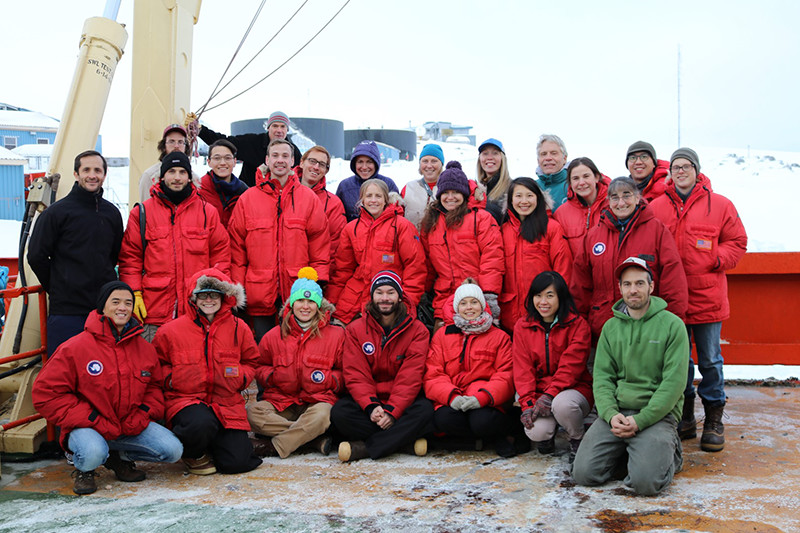
Photo Credit: Deneb Karentz
NSF Advanced Training Program in Antarctica for Early career scientists: Biological Adaptations to Environmental Change.
July has been an eventful month here at Palmer Station. In addition to supporting Bill Detrich's science group, we've had the pleasure of hosting the NSF Advanced Training Program in Antarctica for Early career scientists. Organized by Donal Manahan, of the University of Southern California and Deneb Karentz, of the University of San Francisco, this course brings early career scientists to Antarctica to get first-hand experience conducting research at remote field stations. The labs have been full of activity as the participants planned their projects, collected materials and analyzed their findings. Those participating specialize in fields ranging from the dynamics of microbial communities to the ecology plankton and fish. They've been applying their expertise to understand how global climate change is likely to affect the region, particularly how physiological processes, community composition, and gene frequency will be affected by increasing temperatures on the Antarctic Peninsula. For many, the term "Antarctic biology" brings to mind images of seals, whales and penguins but they are far from the only noteworthy organisms on and around the continent. Research groups this winter have used the R/V Laurence M. Gould to explore the weird and wonderful diversity of invertebrate life around the Antarctic Peninsula. Two of the animals they have focused on are crinoids and sea spiders. Though related to sea stars, crinoids look more like a plant than an animal, which is why they're commonly called "sea lilies." Many species suspend their arms above the seafloor at the end of a long stalk, some crawl along the bottom. All have a ring of featherlike arms surrounding a central mouth. These elegant animals filter food from the water with their branched arms and are integral to many Antarctic sea bottom habitats. At first glance sea spiders bear a striking resemblance to terrestrial spiders, but they have ten or even as many as twelve legs. Instead of hunting, they scavenge the seafloor. There are nearly 300 species of sea spiders in Antarctica, representing all ten families of the taxa. The temperature dropped substantially for the first half of the month, causing the waters surrounding Arthur Harbor to freeze and halting small-boat operations. High winds associated with the cold front also kept us off the nearby glacier during our recreational time. Faced with the prospect of ever-lasting movie monotony the residents of Palmer turned to crafting. Knit sweaters, hats, and neck warmers at various levels of completion have popped up in various corners of station. One neck warmer was even accentuated with a hand-embroidered Antarctica patch. Papier-mâché made a resurgence in July as well. Three penguin piñatas and a solid mâché icefish adorned the tables in the galley for the better part of a week. To the shock of the fish, his penguin friends, along with most of the candy on station, disappeared a few days later. Gone Icefishin’June 30, 2016
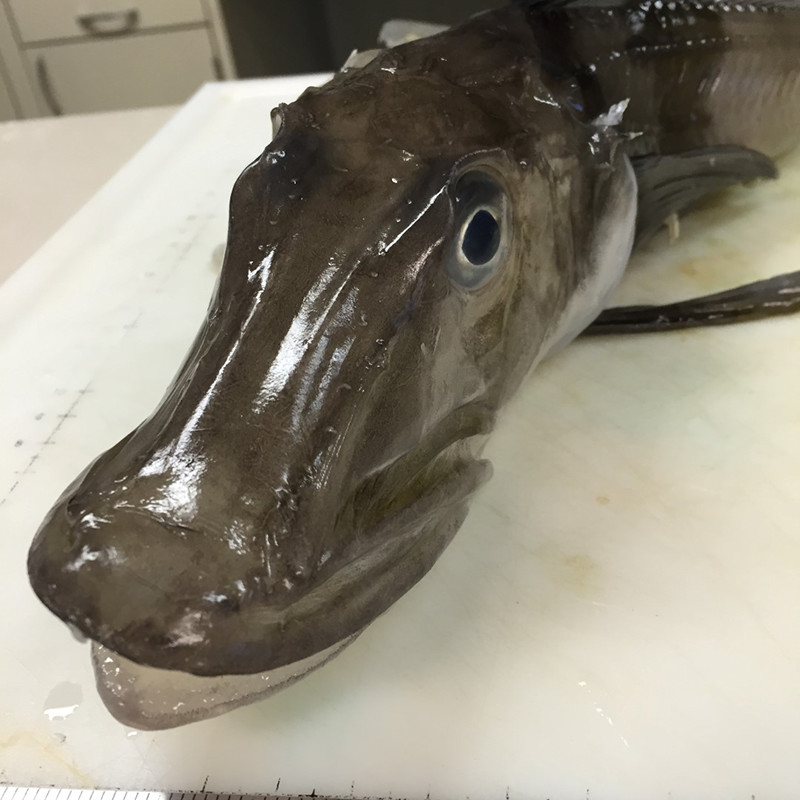
Photo Credit: Ben Cournoyer
Scientists ready an adult female icefish (Chaenocephalus aceratus) for measurement.
We’re past the mid-winter hump and still going strong. With June came the last fishing cruise for the Detrich science group. They are studying the physiological effects of increased water temperatures on various icefish species. A bad day fishing is still better than a good day in the office; if you play your cards right you never have to compare the two. No matter the weather, Dr. Detrich and crew were all smiles. Though the number of adult fish on station is waning, our aquaria have been taken over by embryos in custom-made incubation chambers. We hosted a crew of drillers from Webster Drilling this month. Using a unique compact drill rig they completed an ambitious number of boreholes around station. A personable group, they were also more than eager to give us a brief geology lesson about the ground under our feet. These boreholes are one of the first steps in Palmer’s long term infrastructure modernization plan. Once complete, the upgraded facilities will be capable of supporting research through much of this century. When it’s cold and dark, nothing lifts the spirit like a home-cooked meal. We’re lucky to have two of the best chefs on the ice, Lisa Minelli-Endlich and Zack Morgan. Being veterans of all three U.S. stations they know how to spoil our taste buds after long hours in the chilly and often wet conditions on the peninsula. They whip up Indian, Japanese and down-home southern cooking as good as any specialty restaurants stateside. There’s always a look of satisfaction from those new to station after the first few meals. The kitchen staff also puts together a weekly paper entitled The Hot Mess that details the week’s menu, station events, and national food-related news stories. These small extras are part of the charm that keeps us coming back to Palmer. Early in the month, we put on our dress coveralls to appreciate the creativity of our fellow winter crew members in Palmer’s first ever Ant-ART-ica art show. The event, spearheaded by Jon Charczuk, featured drawings, music, sculpture and theater produced over the previous month. It’s amazing to see what people come up with, including a chocolate sculpture that doubled as hors d’oeuves. As Jon put it, everyone has artistic talent but many never get the opportunity to develop it in a constructive environment. The pieces that resonate with you the most often come from people you wouldn’t expect. Sea Life and Sea IceJune 2, 2016
It’s been another fruitful month here at Palmer Station. With the quickly approaching solstice, we are down to about four-and-a-half hours of daylight, but the shortened days have yet to put a damper on our outdoor activities. We’ve had a great snowpack on the glacier for the majority of the month. By daylight or flashlight, our skis and snowshoes have become hot commodities for recreation. It seems the encroaching darkness hasn’t deterred the wildlife either. The usual neighbors have been showing up all around the station. A few of the weekend boating trips spotted small groups of elephant and fur seals around many of the nearby islands, and a group of nearly 40 Adélie penguins on Janus Island. During a few days of heavy brash ice, a Weddell seal hauled itself out on the pier. After presumably realizing that the proper personal protection equipment needed to help with cargo operations would not fit, he made his way back to Arthur Harbor. We’ve had more exotic visitors as well. During an impromptu ski lesson, a few of our residents stumbled upon an Emperor penguin near Point 8. It stuck around for a few days before making its way back out to sea. May turned out to be a month of ever-present, ever-changing and always inconvenient ice in the waters around station. For the first few weeks, northwest winds packed brash ice in and around the pier. This fused into thick sutured sheets of pancake ice that prevented small-boating operations. Then, a day of shifting winds dispersed the sea ice but promptly pushed medium sized icebergs in and around the deep water channels leading to station, just in time for the arrival of the research vessel Laurence M. Gould. However, inconvenient does not mean impossible. The resourceful crew of the Gould and Palmer Station staff managed to transfer all cargo and personnel, enabling the Gould to depart on time for its fourth scientific fishing trip of the month. The labs have been humming with activity. For much of the month, the Detrich group battled ice, wind, and waves to get their fishing gear in the water. Their diligence paid off with the success of their most recent fishing trip. They have more than enough fish to study the effects of increased water temperatures on the development of icefish embryos. We welcomed a couple more research groups late in the month as well. Dr. Wu will be installing an all-sky hydroxyl airglow imager for the Taylor Group. This instrument will observe atmospheric gravity waves high above the peninsula and complete a network of similar sensors located around Antarctica. Dr. Hosticka will be servicing and calibrating the radionuclide air-particulate monitoring system that sniffs the air for radionuclides. Winter Snows Transform the StationMay 10, 2016
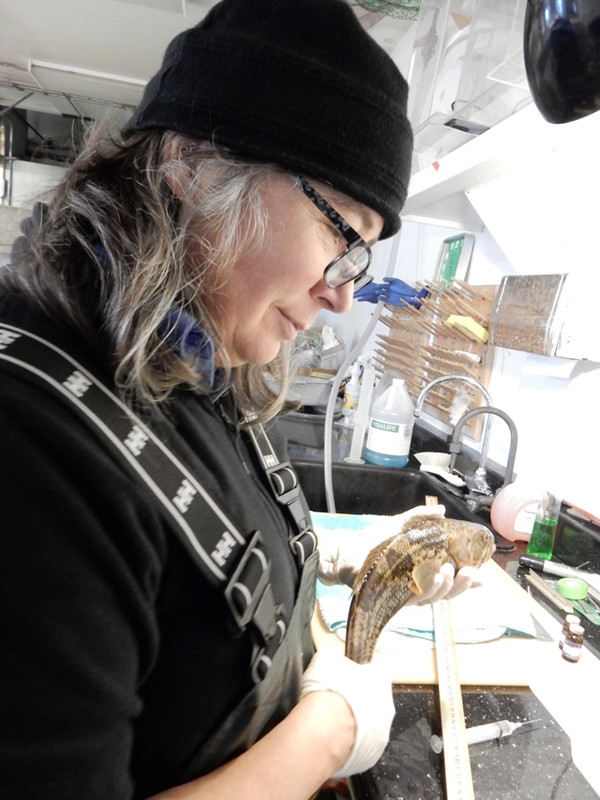
Photo Credit: John H. Postlethwait
Dr. Nathalie Le François prepares to measure an icefish specimen, a bullhead notothen (Notothenia coriiceps).
Though the winter season is only a few weeks old, research at Palmer is off to a great start with three science groups presently on station. This includes the thirty-year-veteran Dr. William Detrich, a biology professor from Northeastern University’s Marine Science Center in Nahant, Massachusetts, whose group is studying Antarctic Icefish. During the past month they have been assembling an elaborate system of tanks and flow-through cells customized to incubate icefish eggs. His group found prosperous fishing grounds off Low Island during the latest southbound transit, entering Hero Inlet with over a hundred healthy icefish. Over the course of the winter they will breed adult fish and monitor icefish egg growth at different temperatures. The Southern Ocean is projected to warm substantially in the coming century and they hope gain insight into potential changes in the fish’s developmental physiology. With the help of research associate Lance Roth and electrician Dan Nielsen, Dr. Yuan Gao of Rutgers University successfully changed out a faulty component of her air sampler. This device captures aerosol particles, including dust blown in from outside Antarctica. From these samples, she can quantify the atmospheric flux of iron on the Antarctic Peninsula. During the Austral summer, the waters surrounding Palmer Station burst with phytoplankton growth, affecting the entire food web. Iron is an integral micronutrient to this process, and its absence could have serious impacts on the base of the food web. Dr. Gao hopes to better understand the amount of iron that is derived from atmospheric sources and determine where on the planet that dust originated. While the newly-arrived station crew was getting their bearings, winter fully enveloped Palmer Station. Mornings often begin with a healthy dose of scraping and shoveling snow—exercise which can be well needed after the tasty spread served up by the galley. Snow fell during a few weeks of calm winds, transitioning the glacier from a blue mound of ice into a snow topped peak. Snowshoes and skis have been flying out of storage with many of our residents enjoying after-work recreation before the sun dips too low on the horizon. On April 22 the residents of Palmer participated in Landscape Photography Magazine’s Earth Day photoshoot. Photographers from all over the world woke up before dawn to capture landscapes bathed in the rising sun. Twenty of the submitted photos will be featured in an upcoming issue. Palmer had a beautiful portfolio of the glacier, icebergs, and even a twilight moon rise. We send our condolences to the other participants, as one resident lightheartedly stated “…I dropped my camera at Palmer once, the picture it took was still better than most of the pictures I’ve taken in my life.” We’ll find out soon if we made the final cut, fingers crossed! Celebrating a Successful SummerApril 5, 2016
Summer at Palmer Station is drawing to a close and the focus has turned to finalizing projects, packing gear and preparing to hand the station over to the incoming Winter 2016 crew who arrive in early April. The Antarctic research vessel, the Laurence M. Gould, arrived, picked up many of the grantees, and departed to take them back north. Three science groups will remain for another few weeks, and they are using this time as best they can to collect as much data as possible before the LMG returns in early April to take them home. In early March, visitors from the last tour ship of the season came ashore. Sea ice and weather had conspired for much of the season to keep visiting ships from landing smaller boats at Palmer, but we still had a productive season welcoming guests to our corner of the world and providing them with a glimpse at the science being done here. Toward the end of the month, we had brief visits from the RSS Ernest Shackleton and the HMS Protector. They came to pick up an autonomous underwater vehicle belonging to the British Antarctic Survey we recovered after a battery failure caused it to drift into our neighborhood. On the social calendar, this month we held a pig roast to celebrate the end of a successful summer season. The chef who prepared the meal was up before the sun to start the barbecue pit, and the effort yielded a delicious meal. The following week we held Palmer Storytelling Night, where everyone on station was invited to share tales of their time on the ice, interesting bits of Antarctic history or funny moments they’d experienced this season. Lastly, many of the people who have been here all season gathered for a screening of the finally-available Star Wars: The Force Awakens. Many of us had spent months trying to dodge spoilers online and preserve as much of the surprise as possible. The payoff was well worth the wait and we can now join the rest of the world in “geeking out” about the film. As turnover approaches, people are trying to squeeze in one last trip up the glacier or out to the islands. Some who made the trip out already have gotten incredibly lucky. One group that went out on the water recently saw a pod of about twenty orcas and several humpback whales surface feeding in the area. But even when there aren’t charismatic megafauna to provide a spectacle, trips out into nature or a moment’s pause to look around and appreciate the scenery, reminds us of what a special place Antarctica, and especially Palmer, can be. End of the Season Art ShowMarch 18, 2016
The end of February brought with it the telltale signs of a season winding down: days are becoming noticeably shorter, the penguin colonies have emptied out and many of the science groups are packing up their gear to return home. Conversations around the station are turning to off-season travel plans and whether people are planning on coming back next year. But at the same time, new activity is also still happening at Palmer. The Amsler group of divers arrived on station and has been busy collecting algae samples at various underwater locations, including the wreck of the Bahia Paraiso, a ship which ran aground in 1989 and sank less than two miles from station. I asked Chuck Amsler, one of the principal investigators for the group, about what keeps them coming back to the Bahia. He explained that because the shipwreck was so relatively new, it gave them a chance to study how living organisms grow on fresh surfaces. Where the ship also creates an unusual environment where the ships helicopter pads block the sun. “A lot of the seaweeds that we normally find much deeper are able to grow in that spot because it’s shaded. So we’re able to collect deep-water reds in relatively shadow water.” As part of their research Chuck and his team analyze the chemical compounds produced by living organisms found in certain kinds of algae to better understand their defenses against predation. The group is hoping also to determine if those compounds could be applied to human pharmacology. They will remain on station for another month to continue their sample collection. In after-hours news, the Palmer community recently held its 10th annual “Open That Bottle Night,” an evening where perhaps a treasured wine or cider is opened to share with friends and colleagues. The event was also an art show that highlighted some of the best photography, drawings, and mixed-media art created on station this season. The galley staff pitched in with a plethora of hors d’oeuvres. The event was a hit with everyone, and provided a great opportunity for the residents to come together and mingle while appreciating some of the most aesthetic reasons to come down to the Ice. This month also saw some prep work being done to ready the station for the arrival of two new rigid-hulled inflatable boats, or RHIBs. These boats, the first of which is slated to arrive during the upcoming winter season, will greatly expand the range and utility of boating operations on station and allow for more and better science to be done. At 33 feet in length, the RHIBs are much larger than the inflatable zodiacs currently used for marine operations. This difference requires some repurposing of space around our boat ramp to make sure they have enough room to be moved in and out of the water. This month we used a full-sized mockup frame to make sure that enough space existed to provide clearance to move the RHIBs around on their trailers. We are all looking forward to their arrival! It will mean that science groups can expand existing research to more collection sites, allowing for broader and more meaningful data. This expanded boating range will also allow new research to be conducted that was previously out of reach. More information about the RHIBs can be found at future.usap.gov Lightning in AntarcticaFebruary 13, 2016
January at Palmer Station has been our busiest summer month yet. Weather and sea ice conditions were favorable for much of the month, and the science teams took full advantage by getting out on the water to conduct sampling and scout for whales whenever possible. There have been several humpback and orca sightings in recent weeks, made possible in large part by the Friedlaender whale group’s tracking efforts. The summer weather also brought an unexpected phenomenon: late in the night on January 2nd, three station residents observed flashes of lightning within a cloud over Hermit Island. Lightning is a rare occurrence in the region because typically cold temperatures do not allow for the types of storms that produce lightning. On January 4, the marine vessel Ushuaia came to visit and sent passengers ashore for a tour of station and an opportunity to meet and visit with science teams and station staff. Among them were descendants of Lionel Greenstreet, who served as first officer on Ernest Shackleton’s 1914-1916 Antarctic expedition aboard the ship Endurance. Greenstreet is credited with keeping Endurance intact for as long as it did before the ship sank. After the crew was forced to abandon the ship and found themselves stranded at Elephant Island, Greenstreet was tasked with using salvaged material from the destroyed Endurance to enable the last remaining sail-worthy lifeboat to navigate in open water. Greenstreet was said to be an eternal optimist despite the brutal circumstances in which he and his men found themselves. His family was immensely proud to be visiting the continent – the first time since Greenstreet left one hundred years prior. The Chilean naval vessel Lautaro dropped off two Portuguese scientists who briefly stayed on station while they studied the effects of climate change on soil and permafrost at nearby Amsler Island. Their work was a continuation of a project that began at Palmer in 2012. After a few days on station, we greeted the Chilean crew from Yelcho Station once again as they arrived to pick up the Portuguese and take them to Yelcho, where they will stay for the remainder of the summer. Most recently, the yacht Enigma paid a second visit to Palmer. Eric Larson of the Human Genome Project was on board, and during his visit to station he gave a presentation to the station community, titled “Science in the Extreme.” He talked about the scientific discoveries and advances that come about when we focus on places and things that are incredibly cold or hot, large or small or otherwise far removed from the ordinary –Antarctica being a prime example. Larson also talked at length about his work mapping the human genome and how that work has led to increased understanding of hereditary diseases. It was a great opportunity to gain insight about the Human Genome Project from one of its primary architects. Baby Penguins!January 25, 2016
There’s been plenty of activity at Palmer Station since the last update, including two visits by the research vessel Laurence M. Gould. During its first stay, the residents of Palmer Station and the crew of the Gould once again combined powers to host an open mic night that featured music, dance, poetry readings and comedy. When it was time for the ship to return to Chile, our sea corals team boarded and left station, having completed their research for the season. Shortly after, the Gould returned with plenty of new folks. The “bugger” team is here, studying the insect Belgica Antarctica, the only terrestrial animal native to the continent. We also have the “whaler” team in the area, and they wasted no time getting out on the water searching for whales and placing tags on the animals to study their behavior. The Gould is currently out on its annual Long Term Ecological Research cruise and we’re looking forward to seeing them again at the end of February. The Gould has not been our only visitor. Last month, an ocean liner named The World came to visit Palmer. The World is a cruise ship that describes itself as “the only private residential community-at-sea.” The suites aboard The World are actually apartments that residents own, and residents dictate the travel itinerary for the ship by voting. They were eager to come ashore and tour the facility as well as meet and talk with our science teams to learn about station life and the work that goes on here. A week later we had a visit from the crew at Yelcho, a Chilean research station that is one of our neighbors on the peninsula. The crew traveled 15 miles by zodiac to reach Palmer and stayed for lunch and much of the afternoon. We have baby birds! The birder team recently reported that chicks have hatched at the nearby Adélie and Gentoo penguin colonies. These, in addition to a skua chick first reported last week, are a welcome addition to the neighborhood. Though the overall penguin populations in the region continue to decline, these chicks are healthy, getting fat and growing quickly. They’re an encouraging and also adorable sight to behold. The chicks can be seen on the Torgersen Island webcam that is currently broadcasting. We also have our first winner of 2016 Palmer Station Boating Bingo! Rob “the haz guy” Bergeron became the first person this season to land on every available island within our boating limits. There are plenty of folks close behind and ready to join him at the top. Congrats to Rob! The Christmas season at Palmer meant curating a list of holiday films to watch (and a discussion of whether or not Die Hard is or is not the greatest holiday film of all time), a secret Santa gift exchange and a giant feast. The community came together to put up our tree and decorate the station, and on Christmas Day our chefs wowed everyone with a meal fit for royalty. The main courses were seared duck with citrus miso glaze on pumpkin gratin, seafood-stuffed lobster tails, a New England pork pie, and seared pork tenderloin topped with pate en croute. For dessert, the selection included egg nog mousse, lavender infused egg custard, chocolate-dipped gingerbread truffles, fresh apple gallette and an assortment of holiday cookies baked by volunteers from station. |
Home /
Around the Continent /
Palmer Station Archives - 2016
"News about the USAP, the Ice, and the People"



For USAP Participants |
For The Public |
For Researchers and EducatorsContact UsU.S. National Science FoundationOffice of Polar Programs Geosciences Directorate 2415 Eisenhower Avenue, Suite W7100 Alexandria, VA 22314 Sign up for the NSF Office of Polar Programs newsletter and events. Feedback Form |



